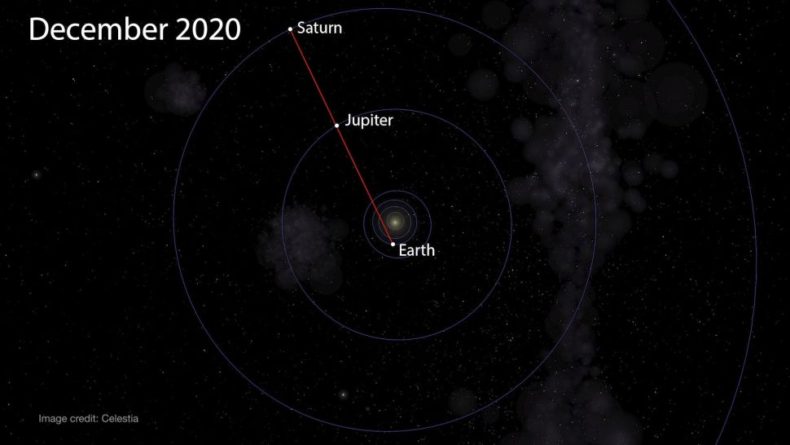
In this year of darkness, today brings something to celebrate. Winter solstice is the shortest day of the year, which means the light will finally start returning. And this year, the first day of winter also marks a special celestial event — the Jupiter-Saturn Great Conjunction.
Imagine that our solar system is a racetrack, and each of the planets is a runner circling the sun in their own lane, with the Earth toward the center of the stadium, Henry Throop, a NASA astronomer, said in an explainer. “From our vantage point, we’ll be able to see Jupiter on the inside lane, approaching Saturn all month and finally overtaking it on December 21.”
It’s been almost 800 years since Saturn and Jupiter were this close in our sky and not too near to the sun or low in the sky to be seen by most Earthlings. Saturn is much dimmer than Jupiter, because it’s smaller and almost twice as far away, but their paths through our sky will make them appear so close from our vantage point so as to almost appear as one.
Poets may find metaphors or deeper meaning in this fortuitous alignment of the planets, but from a scientific perspective it’s simply a cool demonstration of geometry and our place in the Milky Way relative to these two neighbors.

I’ve been observing the two bright planets all year, watching them slowly converge. Last Thursday, I went for a run at sunset and as the sky went from shades of pink and red to deep blue turning to black, the bright glow of Jupiter and Saturn put on a show in the southwest sky.
I’m writing this on Sunday night (12/20) and this evening after sunset I spent some time looking at the two planets. Saturn and Jupiter are still distinct, both with the naked eye and through low powered binoculars. Tonight, they will almost converge when observed from Earth. (According to Joe Rao at Space.com they probably still won’t look like a single point, at least not to people like me with good eyesight. But they will still look really cool!)
One of my favorite things about living in the rural West is looking up at the dark sky. I once stayed up most of the night with my friend Rosemerry, gazing at the sky full of of stars overhead and pondering our place in this vast universe. It’s a thing I can’t get enough of — that feeling of being totally at home in my surroundings while also sensing the wondrous expanse beyond my native planet.
I can’t wait to get more of that tonight, and I hope you will too. The two planets are bright enough to be seen without any aid, but if you live in a very light city or are unlucky enough to have cloudy skies tonight, the Lowell Observatory is hosting a livestream of the event on YouTube, which you can watch here.
Images:
Photo of Jupiter and Saturn over the landscape of the Sacred Mountains of Gran Canaria by Starry Earth, via Flickr.
Diagram of Jupiter, Saturn and Earth from NASA.
Are you sure that first picture is from Gran Canaria. Looks a lot like the view from El Teide on Tenerife
Like you, and others, I have been watching the evening and night sky, particularly when it is clear. I do look up and out on cloudy evenings and seeing based upon my memory and imagination. Your comment “…that feeling of being totally at home in my surroundings…” got me to thinking about how to be totally at home in the Solar System and beyond. Understanding the geometry of the converging orbits of Jupiter and Saturn helped make the proverbial once-in-a-lifetime experience all the more personal. I reckon I am a bit closer to being at home in my outer surroundings.